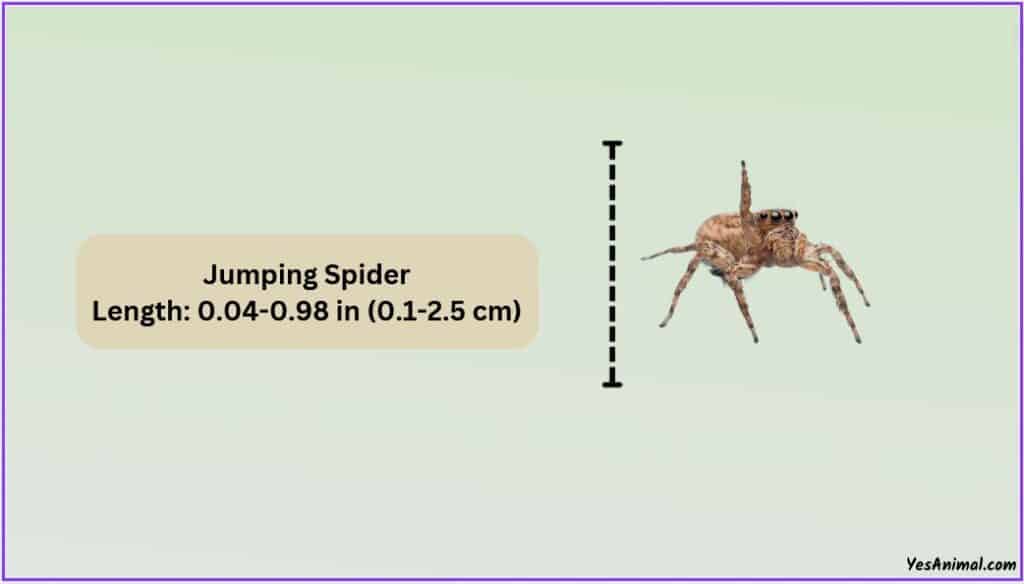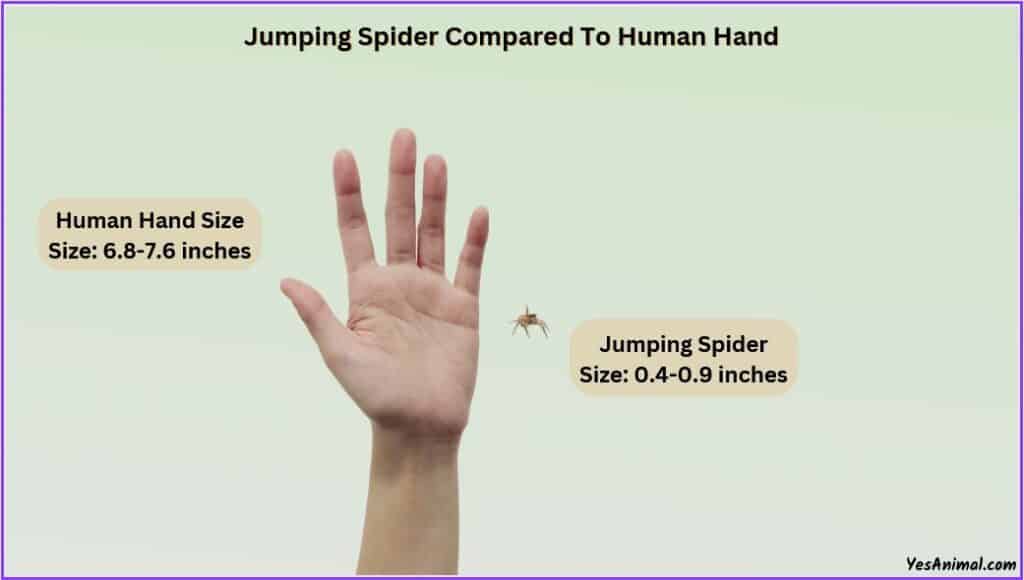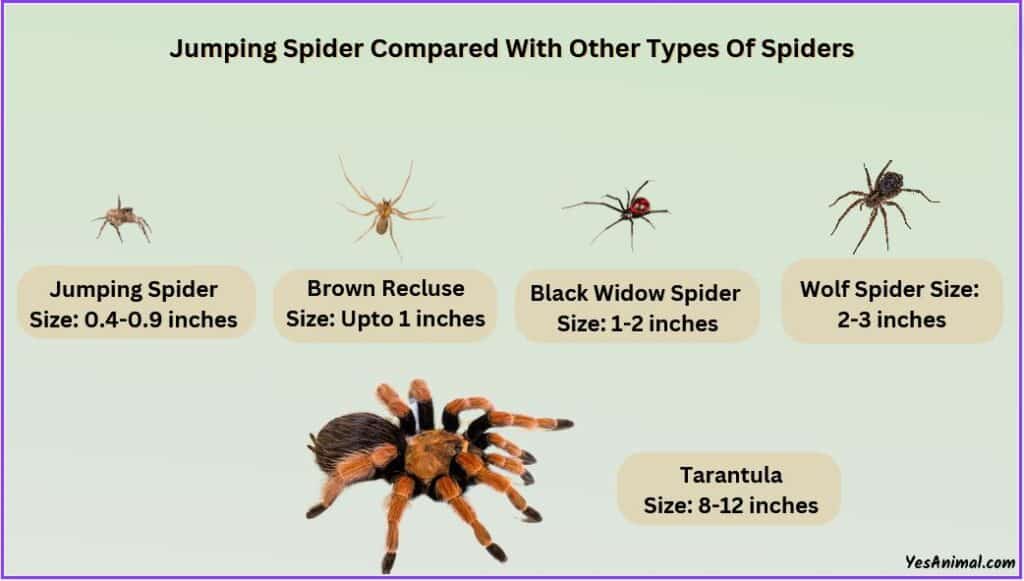Last Updated on April 10, 2023 by Amin Tawar
Jumping Spider Length

A subfamily of spiders known as Salticidae is known as jumping spiders. Spiders that leap can live up to their name because they stalk their prey instead of entangling it in a web when they hunt.
Since they are quite timid, jumping spiders will typically flee from humans when they approach. They can’t deliver a sufficient dose of venom for it to be harmful, so their venom is also harmless to humans.
It’s interesting to note that the Jumping spiders are exceptional jumpers and can leap distances between 10 and 40 times their body length.
Adult jumping spiders can range in size from 1 to 25 mm (0.04-0.98 in), but the majority are between 5 and 10 mm. All jumping spiders are non-lethal to people, though the larger species can bite you painfully if you handle them roughly.
Additionally, the jumping spider’s leg span is approximately 10.4 millimeters (1.04 cm).
| Jumping Spider | Centimeter | Inches |
| Body length | 0.1-2.5 cm | 0.04-0.98 in |
| Leg span | 1.04 cm | 0.409 in |
Jumping Spider Weight
Another way to describe the size of a spider is to look at its weight. Jumping spiders are of different types, and each one of these weighs differently depending on several factors such as their diet, lifestyle, and location.
For example, a jumping spider with an average length of 5 to 6 mm, Habronattus Calcaratus weighs an average of 13.5 mg for males and a little more for females. However, the largest jumping spider is the Hyllus Giganteus, these are much larger and heavier than other moderate and small size Jumping spiders.
| Jumping spider (Habronattus Calcaratus ) | Ounce | Grams |
| Weight | 0.000476 ounce | 0.0135 g |
Jumping Spider Full Size And Average Size
The largest size of the Jumping spiders can reach up to 25 mm, but most of the Jumping spiders are of moderate to small size ranging between 5 to 10 mm.
There are only a few giant jumping spiders that reach full size. Otherwise, the rest of the jumping spiders are tiny.
Jumping Spider Size Comparison To Human Hands

Jumping spiders are very small, with tiny sizes. If you see one of the average-sized jumping spiders on a human hand, it would not even be the size of your small finger.
This is because the average size of human hands is about 7.6 inches, while the size of a jumping spider is just 0.04-0.98 inches. You can imagine how small these spiders are compared to human hands.
Jumping Spider Vs Wolf Spider Size Comparison
Let’s compare the jumping spider to other species now that we’ve compared it to human beings and other species of animals.
First off, the wolf spider family is a sizable one in terms of size and mass.
Wolf spiders, as opposed to jumping spiders, have four smaller eyes in a row below their four larger eyes.
The size difference between the Wolf spiders and jumping spiders is considerable. The wolf spider weighs less than an ounce and has an overall length of between 10 and 35 mm (0.4 and 1.38 in).
The jumping spiders, in contrast, are about 0.04 to 0.98 inches long and weigh about 0.0135 g. So, in terms of all length, leg span and weight the jumping spider is much smaller than the Wolf spider.
| Spider type | Body length | Leg span | Weight |
| Jumping spider | 0.04 to 0.98 inch | 0.409 in | 0.000476 ounce |
| Wolf spider | 0.4-1.38 inch | 2-3 inches | less than an ounce |
Jumping Spider Vs Black Widow Size Comparison

Due to their small, black bodies and relatively short legs, jumping spiders are frequently mistaken for black widow spiders.
A black widow could also jump, no matter how far, to the ground (just like jumping spiders). Jumping spiders and the Black widow, however, differ physically in a number of ways, including size.
The Black widow’s average overall body length ranges from 3 to 10 mm, its leg span is about one-half inch long and the weight of the spider is approximately about 0.035 ounces. In this case, too, the jumping spider is quite smaller than the Blak Widow.
| Spider type | Body length | Leg span | Weight |
| Jumping spider | 0.04 to 0.98 inch | 0.409 in | 0.000476-ounce |
| Black widow spider | 1-2 inches | ½ inch | 0.035 ounces |
Jumping Spider Vs Brown Recluse Size Comparison
Although the jumping spider resembles the brown recluse in appearance, it is not poisonous.
Brown recluses have light brown bodies that are marked with a darker, violin-shaped pattern as adults.
Adult brown recluse spiders are roughly the size of a quarter, though they can vary in size. Rarely do tiny recluse spiders grow to be half an inch long?
A brown recluse spider has an overall length of 6 to 20 millimeters (0.24 to 0.79 in) and a leg span of approximately 2.5 cm (1 inch). Brown recluse spiders are incredibly small, weighing only 0.001 lbs (0.45 grams).
| Spider type | Body length | Leg span | Weight |
| Jumping spider | 0.04 to 0.98 inch | 0.409 in | 0.000476 ounce |
| Brown Recluse | 0.24 to 0.79 inches | 1 inch | 0.016 ounce |
Jumping Spider Vs Cellar Spider Size Comparison
The Cellar spiders are pursued and killed by the jumping spiders. Pholcid spiders are also referred to as daddy-long-legs spiders or cellar spiders.
A long-bodied cellar spider’s adult body is about 2–10 mm (0.08–0.39 inch) long, and her front legs are about 50 mm (1.97 inches) inches long.
| Spider type | Body length | Leg span | Weight |
| Jumping spider | 0.04 to 0.98 inch | 0.409 in | 0.000476 ounce |
| Cellar Spider | 2–10 mm (0.08–0.39 inch) | 50 mm (1.97 inches) | 0.001 lb (10-15 g) |
Conclusion
And that was everything you need to know about the size of the Jumping spider. I hope this article was helpful and you got something useful from it.
Thank You For Reading!
Related Articles You May Like